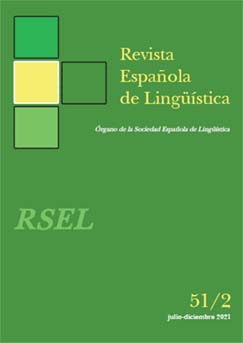Biolinguistics: Linguistic Theory and Cognitive Science
https://doi.org/10.31810/rsel.51.2.6
Keywords:
Biolingüística; Psicolingüística; Neurolingüística; Ciencia cognitiva; teoría lingüística.Abstract
This contribution proposes an introduction to the development and objectives of biolinguistics, as well as a reflection on its status as a scientific discipline. We show that, in general, the consideration of language as a biological property of our species, and not only as a cultural achievement of it, has had a remarkable effect on the development of linguistic theory, and on its connection with other fields of cognitive science, notably with psycholinguistics. We conclude that, although there is still much to be understood about how the brain processes and stores languages, about how this faculty evolved in our species, and how it develops in each person, the integration of theoretical linguistics and cognitive neuroscience is making us increasingly able to turn those mysteries into empirically tractable problems.
Downloads
References
Álvarez García, E. (2018): Influencia léxico-semántica en el procesamiento sintáctico: un estudio con oraciones de relativo en español, Tesis Doctoral, Universidad de León.
Barrow, J.D. (1994): Teorías del todo, Crítica, Barcelona.
Boeckx, C., M.C. Horno y J.L. Mendívil (eds.) (2012): Language, from a biological point of view, Cambridge Scholars, Newcastle.
Brennan, J. y Pylkkännen, L. (2008): «Processing events: Behavioral and neuromagnetic correlates of aspectual coercion», Brain and Language 106, pp. 132-143.
Chomsky, N. (1975): Reflexiones sobre el lenguaje, Barcelona, Ariel.
Chomsky, N. (1986): Knowledge of language. Its nature, origins and use. Praeger, Nueva York.
Coulson, S., & Lovett, C. (2010): «Comprehension of non-conventional indirect requests: An event-related brain potential study», Italian Journal of Linguistics 22, pp. 107-124.
Hauser, M.D., N. Chomsky y W.T. Fitch. (2002): «The faculty of language: What is it, who has it, and how it evolved?», Science 298, pp. 1569-1579.
Horno, M.C., R. Timor y A. Sarasa. (2017): «¿Qué ocurre cuando comparamos dos unidades léxicas sinónimas? Un estudio psicolingüístico sobre la naturaleza de la sinonimia», Revista de Lingüística Teórica y Aplicada 55, pp. 149-168.
Katz, A.N., y Ferretti, T.R. (2001): «Moment-by-moment reading of proverbs in literal and nonliteral contexts», Metaphor and Symbol 16, pp. 193-221.
Kutas, M., y Federmeier, K.D. (2000): «Electrophysiology reveals semantic memory use in language comprehension», Trends in Cognitive Sciences 4, pp. 463-470.
Poeppel, D. (2012): «The maps problem and the mapping problem: Two challenges for a cognitive neuroscience of speech and language», Cognitive Neurophychology 29, pp. 34-55.
Preston, K. y M. Pigliucci (eds.) (2004): Phenotypic integration: Studying the ecology and evolution of complex phenotypes, Oxford University Press, Oxford.
Searle, J.R. (1975): «Indirect speech acts». En P. Cole y J.L. Morgan (eds.), Syntax and Semantics, Vol. 3: Speech Acts, Nueva York, Academic Press, pp. 59-82.
Weiland, H., Bambini, V. y Schumacher, P.B. (2014): «The role of literal meaning in figurative language comprehension: Evidence from masked priming ERP», Frontiers in Cognitive Neuroscience 8, pp. 1-17.
Weinberg, S. (1992): Dreams of a final theory, Nueva York, Vintage.
Published
How to Cite
Issue
Section
Copyright (c) 2021 Revista Española de Lingüística

This work is licensed under a Creative Commons Attribution-NonCommercial-NoDerivatives 4.0 International License.











